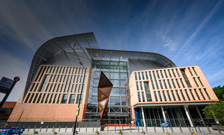Crick Institute receives royal seal of approval
 Europe’s largest biomedical research centre under one roof- the Francis Crick Institute was officially opened by HM The Queen today.
Europe’s largest biomedical research centre under one roof- the Francis Crick Institute was officially opened by HM The Queen today.
HM The Queen and HRH The Duke of Edinburgh toured the impressive building, meeting some of the scientists, staff and major donors who have contributed to the purpose-built facility at St Pancras, London.
The Francis Crick Institute (the Crick) is a research centre dedicated to find new ways to prevent, diagnose and treat conditions such as cancer, heart disease and stroke, infections and neurodegenerative conditions like motor neurone disease. At full capacity next year it will be home to 1,250 scientists and a further 250 support staff.
Its founding partners are the Medical Research Council (MRC), Cancer Research UK, Wellcome, UCL (University College London), Imperial College London and King's College London. King’s will support the institute’s huge collaborative projects with its strong clinical and multi-disciplinary research base. It will draw on expertise from across King’s including King’s Health Partners, its Biomedical Research Centre with Guys and St Thomas’s NHS Trusts, as well as seconding staff from departments such as Natural & Mathematical Sciences.
HM The Queen and HRH The Duke were greeted on arrival by Chairman Sir David Cooksey and Director Sir Paul Nurse. They then visited the Advanced Sequencing facility where HM The Queen started the sequencing of the whole of Sir Paul Nurse’s DNA – his genome.
Paul Nurse, director of the Crick, former president of the Royal Society and Nobel laureate, said: “It was a delight to welcome the Queen to our new building for the Francis Crick Institute and show her some of the science that we are carrying out to understand the human body better in health and disease.”
He added: “As part of the visit, she sequenced my genome and we’ll find out the results in the coming weeks. In our normal work at the Crick, we use this type of advanced sequencing to understand more about genetic influences on disease.”
HRH The Duke of York then joined the royal party to listen to a short lecture on the influenza virus in the Wellcome Auditorium before all met portrait artist Robert Ballagh to unveil a portrait of Francis Crick and a plaque to mark the opening of the institute.
A registered charity, construction of the new £650 million building for the Crick was completed in August this year following a major fundraising campaign led by Cancer Research UK. Researchers from the Crick's legacy institutes are moving into the new Crick Lab in a phased process that will run until the end of 2016.
King’s will have around 80 research spaces in the building- giving researchers the opportunity to work closely with those from the Crick, Imperial and UCL on collaborative projects, whilst having access to the range of technology platforms and facilities in the new building.
Professor Edward Byrne AC, President and Principal of King’s College London, said: ‘As a founding academic partner King’s is delighted to play a key role in this world-leading institute, bringing experts from a wide range of disciplines to work collaboratively under one roof. King’s has an excellent track record in bringing scientists and clinicians together to translate research into innovative treatments as quickly as possible. Our expertise will strengthen further the institute’s ability to bring basic and applied science together with clinical knowledge, to benefit patients across the UK as well as society as a whole.’
King's researchers: Snezhana Oliferenko, Francesca Ciccarelli, Patricia Barral, Jeremy Carlton, Franca Fraternali, Kathleen Steinhofel, Paula Booth, Sergi Garcia-Manyes, Corinne Houart and Shukry Habib have now moved to the Crick. Their secondments and attachments will see them working in a range of exciting areas including cancer systems biology, using big data and cell and molecular biophysics.
Additionally, some 41 PhD students from King’s have started work at the Crick– with an aim to recruit about 50 students per year to reach a total steady-state cohort of around 200. Students following the programme are registered at one of their choice of the Crick’s university partners.
*The building was designed by HOK working with PLP Architecture and developed with input from scientists, local residents and community groups. To reduce its visible mass, one-third of the structure is below ground, with laboratories arranged over four floors above ground. The building has almost one million square feet of floor space (over 17 football pitches).
ENDS